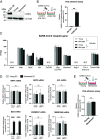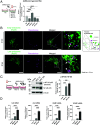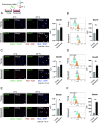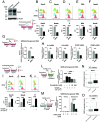SARS-CoV-2 uptake and inflammatory response in senescent endothelial cells are regulated by the BSG/VEGFR2 pathway
- PMID: 40720650
- PMCID: PMC12337311
- DOI: 10.1073/pnas.2502724122
SARS-CoV-2 uptake and inflammatory response in senescent endothelial cells are regulated by the BSG/VEGFR2 pathway
Abstract
Aging is a risk factor for severe COVID-19, characterized by vascular endothelial dysfunction. Although possible susceptibility of vascular endothelial cells (ECs) to SARS-CoV-2 infection has been suggested, the details of entry into cells have not been clarified. Previously, we reported that in an aged mouse model of severe COVID-19, ECs show a massive viral uptake and inflammatory response. Here, we focused on the endocytic capacity of senescent ECs. We found that the senescent ECs showed high endocytic capacity and SARS-CoV-2 virus uptake. This triggers an nuclear factor-kappa B (NF-κB) pathway-mediated inflammatory response. Further, Basigin enhanced endocytosis in the senescent ECs by activating the intracellular vascular endothelial growth factor signaling. Thus, EC senescence is associated with enhanced SARS-CoV-2 endocytosis and subsequent vascular endothelial dysfunction. This could prove a potential target for treating severe COVID-19 in older adults.
Keywords: BSG; COVID-19; SARS-CoV-2; senescence; vascular endothelial cell.
Conflict of interest statement
Competing interests statement:The authors declare no competing interest.
Figures






Similar articles
-
Cytosolic DNA initiates a vicious circle of aging-related endothelial inflammation and mitochondrial dysfunction via STING: the inhibitory effect of Cilostazol.Acta Pharmacol Sin. 2024 Sep;45(9):1879-1897. doi: 10.1038/s41401-024-01281-0. Epub 2024 Apr 30. Acta Pharmacol Sin. 2024. PMID: 38689095
-
CCR2 Signaling Restricts SARS-CoV-2 Infection.mBio. 2021 Dec 21;12(6):e0274921. doi: 10.1128/mBio.02749-21. Epub 2021 Nov 9. mBio. 2021. PMID: 34749524 Free PMC article.
-
CircSARS-CV2-N1368 from SARS-CoV-2 impairs endothelial cell function through the upregulation of ATF7 to activate TLR4/NF-κB/ROS signaling.Acta Pharmacol Sin. 2025 Aug;46(8):2180-2195. doi: 10.1038/s41401-025-01516-8. Epub 2025 Mar 11. Acta Pharmacol Sin. 2025. PMID: 40069492 Free PMC article.
-
Signs and symptoms to determine if a patient presenting in primary care or hospital outpatient settings has COVID-19.Cochrane Database Syst Rev. 2022 May 20;5(5):CD013665. doi: 10.1002/14651858.CD013665.pub3. Cochrane Database Syst Rev. 2022. PMID: 35593186 Free PMC article.
-
Workplace interventions to reduce the risk of SARS-CoV-2 infection outside of healthcare settings.Cochrane Database Syst Rev. 2022 May 6;5(5):CD015112. doi: 10.1002/14651858.CD015112.pub2. Cochrane Database Syst Rev. 2022. Update in: Cochrane Database Syst Rev. 2024 Apr 10;4:CD015112. doi: 10.1002/14651858.CD015112.pub3. PMID: 35514111 Free PMC article. Updated.
References
-
- WHO, World Health Organization 2023 data.who.int, WHO Coronavirus (COVID-19) dashboard. https://data.who.int/dashboards/covid19/. Accessed 24 October 2024.
MeSH terms
Substances
Grants and funding
- JP20fk0108537h0001/Japan Agency for Medical Research and Development (AMED)
- JP22wm0325053h0001/Japan Agency for Medical Research and Development (AMED)
- JP243fa627005/Japan Agency for Medical Research and Development (AMED)
- JP23wm0125008/Japan Agency for Medical Research and Development (AMED)
- JP22K19610/OU | Research Institute for Microbial Diseases, Osaka University (RIMD)
LinkOut - more resources
Full Text Sources
Medical
Miscellaneous

